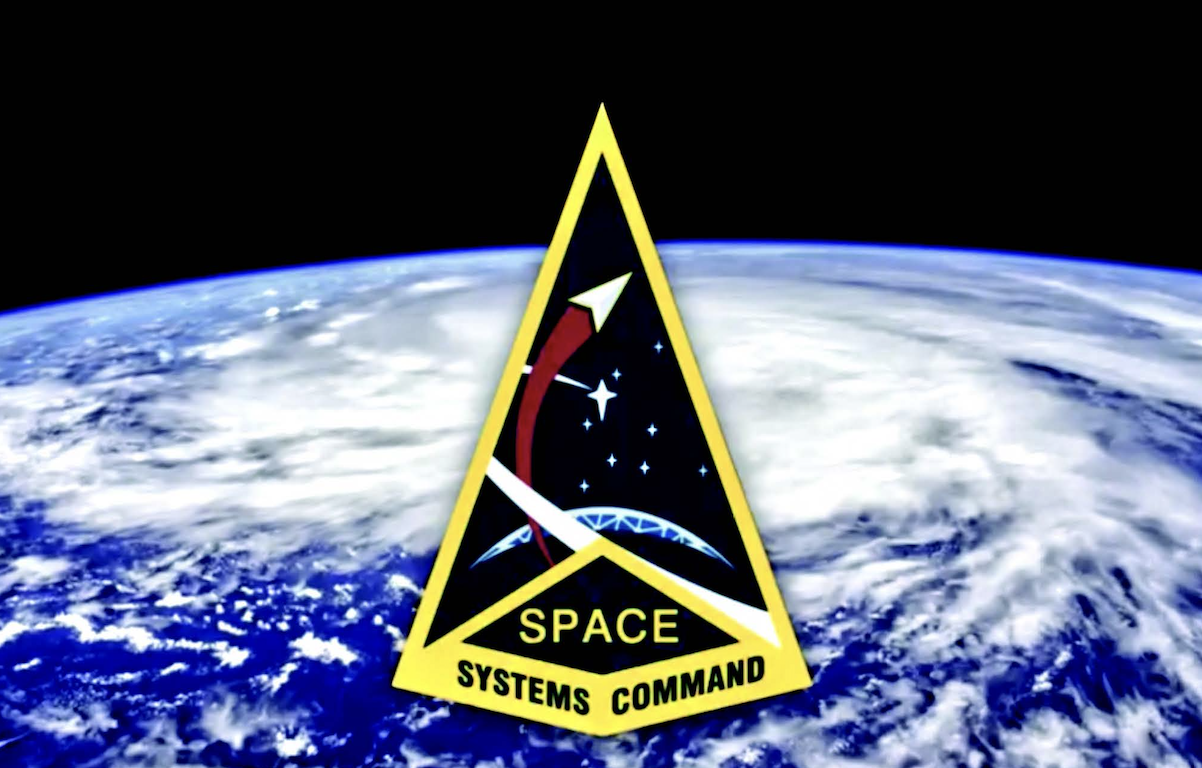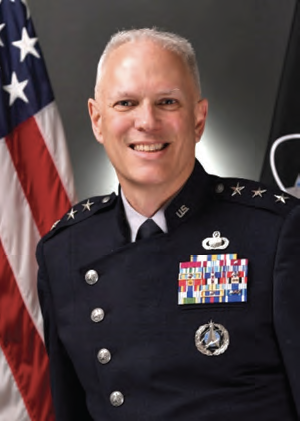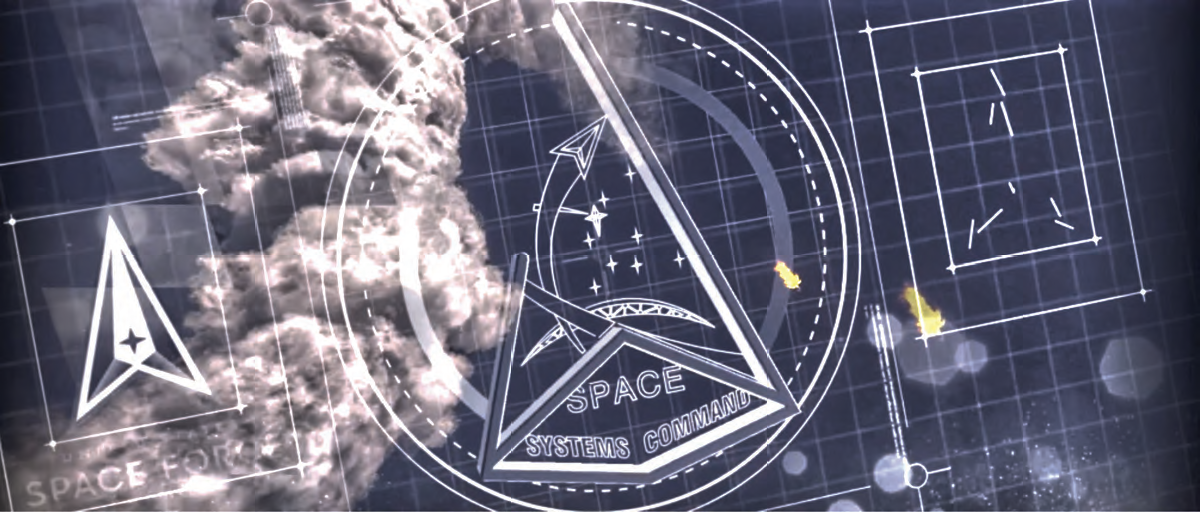Lt. Gen. Philip Garrant assumed command of Space Systems Command on February 1, 2024, taking the reins from Gen. Michael Guetlein, who is now serving as the USSF’s Vice Chief of Space Operations.

Garrant is now responsible for leading SSC’s global workforce of more than 15,000 military, civilian, and contractor personnel, as well as overseeing an annual $15.6 billion space acquisition budget, which ensures our Nation’s warfighters have the premier space capabilities required to counter the threats in today’s and tomorrow’s contested space domain.
His command at SSC is something of a welcomed return: earlier in his career, he held leadership roles with SSC’s predecessor organization headquartered at Los Angeles Air Force Base.
Prior to his new role as Commander, Garrant served as the Space Force’s Deputy Chief of Space Operations, Strategy, Plans, Programs, and Requirements at the Pentagon in Arlington, Virginia.
He also previously served as a program executive officer in the Missile Defense Agency and spent time at the Air Armament Center.
Lt. Gen. Garrant recently sat down in SSC’s Public Affairs studio to talk about his vision for the command, with the Space Force Association’s Matt Anderson.
(The interview has been edited and condensed.)
General, it’s been about a month since your change of command — what do you see after 30 days?

Lt. Gen. Philip Garrant
Lt. Gen. Philip Garrant
We’re going to keep building on the work that was started before me. (Former SSC Commander) Gen. Michael Guetlein really emphasized a culture of understanding the threat and getting after acquisition: going faster, exploiting capabilities that we have, buying commercial capabilities where we can, and building only when we must — relying on the defense industrial base to do that; not just with traditional (defense) ‘primes,’ but with new entrepreneurial companies, accelerating companies that might be brand new to the space business area and excited to be partners with us.
From a priority perspective, we’re going to continue (USSF Chief of Space Operations) Gen. Saltzman’s vision on the theory of competitive advantage — things such as expanding on mission-focused commands, Integrated Mission Deltas, System Deltas.
(We’re going to have a) huge focus on the workforce and the organization. SSC and its predecessor organizations have gone through a lot of change. Change never ends, but it seems over the last five or six years, it’s been constant. We’re going to finish out what a field or acquisition command looks like, including the command staff structure. And then really help the workforce understand their roles — the tie to the mission and acquisition fundamentals.
Having smaller teams focused on the mission, working closely with the operators and partners such as Space Training and Readiness Command’s Commander Maj. Gen. Tim Sejba and Space Operations Command’s Lt. Gen. David “Rock” Miller, to give them what they need.
Understanding those needs — that’s my role as the commander here at SSC. I don’t have acquisition authorities. I am an organize, train, and equip function. I enable their success. (U.S. Secretary of the Air Force) Frank Kendall said, your measure is the quality of the work that the organization produces. So, that’s going to be my focus: on the people and delivering those capabilities.
When you hear someone talking about Space Force or Guardians, what do you hope they think about?
Lt. Gen. Philip Garrant
The first thing I want them to think about is that we are a military branch, a military service. We are part of the Department of the Air Force. We’re partnering very closely with the Air Force and the other services, and
the Joint Force. I want them to know that our Guardians are the men and women who provide these amazing space and defense capabilities every day. Even in Space Systems Command, we are doing operations and providing support to the warfighter and to the Nation.
Probably the best and easiest example is the Global Positioning System (GPS): the satellites that provide Positioning, Navigation and Timing (PNT) to the world and the world economy. Folks get on their phones and look at the best way to drive where they need to go. That’s courtesy of GPS.
I want Americans and our adversaries to know that the Guardians are on watch, on the job, on the mission, delivering capability every single day.
We can’t talk about acquisitions if we don’t talk about the budget. The Fiscal Year 24 budget continues to be working under a Continuing Resolution. Can you talk about how that affects your command and what your team is doing to mitigate some of those risks?
Lt. Gen. Philip Garrant
We’ve been very successful as a Space Force in the last four years. We have doubled our budget from about $15 billion to about $30 billion in the 2024 Planning Programming, Budgeting and Execution process. I honestly believe that would not have been the case if we did not have a Space Force as a separate service. Having said that, we desperately need an appropriation, We’re hopeful that this will be the last CR that just recently got enacted and we’re going to be halfway through the fiscal year.
There are huge, significant, real impacts to the continuing resolution. I’ll give you a few examples in the space launch capability. We received significant funding in ‘24 to upgrade and modernize our space ports: direct impact to our commercial who launch at our space ranges.
With the CR, we cannot spend that money effectively, and we’re limited in how much we can spend on Space Force space port modernization.
Procurement contracts are written as requirements contracts with the intent of buying a certain number every year. Under a CR, we have less funding, we’re not able to buy as many launches — that will have a long-term and continuing ripple effect downstream as we try to launch out our constellations.
The ranges themselves — we can’t operate the ranges. We can’t modernize the Satellite Control Network that is used on the ranges to talk to our satellites and our space vehicles in a launch environment.
And then another final example is the Joint Commercial Operations Cell, the JCO, where we take unclassified data from commercial partners and allied partners and make that data universally available to joint operations around the world, to provide Space Domain Awareness (SDA). That funding is also limited. So, real impacts are involved when not having a budget.
What do you want Guardians and Airmen thinking about regarding the Great Power Competition?
Lt. Gen. Philip Garrant
You’ll notice when you walk around the Schriever complex, right here on the Los Angeles Air Force Base, all our banners remind everybody about the threat. When you walk into my headquarters building, there’s a shot clock (countdown timer) in the foyer when you walk in. It’s counting down to the year 2026.
The plan in the Great Power Competition is we will be ready and with resilient space architectures to operate in a competitive environment by that time. We have the pacing challenge of China. We have the acute threat of Russia.
Those threats are real. We can see what’s happening in Ukraine, we can see what’s happening in Israel, we can see what’s happening in the South China Sea and parts of INDOPACOM - some of those adversaries are putting up threats every single day.
The Space Force was really designed and built around Great Power Competition. We’re only four years old. We like to think that we’re great in our homework and fine-tuning those dials, and making some changes to be even more effective, not just efficient.
Can you explain in layman’s terms the difference between Space RCO (Rapid Capabilities Office) and SDA (Space Development Agency)?
Lt. Gen. Philip Garrant
(Assistant Secretary of the Air Force) Frank Calvelli is a fantastic partner, and we couldn’t do our mission without him.
And, of course, the SSC Program Executive Officers work for Honorable Calvelli. I like to talk about people who spend Space Force budget in terms of their superpowers — and this is anybody who spends budget. But the big three you named: SSC, SDA, and Space RCO.
Derek Tournear (Director, SDA) has mastered the use of mid-tier acquisition. He has really figured out a way to effectively use that to rapidly and consistently reconstitute new technology every two to three years as we build out this proliferated LEO (Low Earth Orbit) architecture. But in the end, his data contributes to the fight and goes to the warfighter. So that’s one part of the team, building out one part of the enterprise, using a specific superpower.
Space RCO — by statute — gets their requirements directly from the combatant commander at U.S. Space Command, but again, ultimately delivers capability and, in many cases, transitions programs to SSC for final fielding and sustainment.
And then SSC: for decades, all the way back to its origin with General Schriever in the Western Development Division, has a proven history of developing and fielding exquisite capability in many, many mission areas, as well as launching and operating the ranges.
We each have a part to play, and we couldn’t complete the enterprise mission without each other.
Can you talk about how industry and your team here at SSC could better work together?
Lt. Gen. Philip Garrant
I’m a career acquisition officer. I like to say that anybody can be a program manager. It’s just cost, schedule, performance, and risk. It’s easy. What’s hard are the relationships, the personal connections. And I think that holds true for industry. I think the best thing we can do is communicate.
Even though I don’t have acquisition authorities or program budget at SSC, I’m going to be available to industry. I’m
going to make sure that our program managers and Program Executive Officers communicate, as well. If we’re not talking, when it comes time to have the tough conversations, if you don’t have the good conversation as foundation, it makes it that much harder.
We have an organization that we call SSC’s Front Door. It’s a way for industry to get into SSC and to learn about our business opportunities — that’s another fantastic connection point for industry.
And then organizations such as the Space Force Association and some of the other non-profits that are in the space industry are incredibly important for networking, for connection. One of our Guardian ideals is connection.
What about the new Integrated Mission Deltas and System Deltas – can give us your perspective on how it’s gone in the last six months, and perhaps what we’ll see in the future?
Lt. Gen. Philip Garrant
Gen. Saltzman’s primary motivation for Integrated Mission Deltas is readiness. It’s all about ready, resilient, combat- credible forces to present to the combatant commanders. And in his mind, we never had a single unity of command, a single mission command focused on all four aspects of readiness that we measure: people, training, equipment, and sustainment.
Those were bifurcated in space: you had the operational field command, and you had an acquisition field command. With the IMDs, for the first time, under a single commander — with a partner from their counterpart — we have an acquisition leader and an operations leader singularly focused on delivering capability, readiness, and readiness improvements.
We currently have two provisional IMDs: one doing Electronic Warfare (EW), one doing PNT (Positioning, Navigation and Timing.) And then we have partner System Deltas.
If a system is developed, delivered, and fielded in operations, that’s going to be in the IMD. If it’s still under development — very typical of large programs that may be years away from being fielded — that’s going to be in a System Delta. But the idea is to get all the right players connected and have the money and the authorities, and the mission command control to be able to drive increased readiness.
Now, the acquisition still goes through the acquisition chain. The program managers still work for the PEOs who still report to Honorable Calvelli. But you’ve got that singular focus with the commander who can reach into the sustainment funds, identify true operational needs, and prioritize those needs.
We’re working through what’s the next step on IMDs and System Deltas in the next coming weeks and will take a decision brief to Secretary Kendall and General Salzman to say, okay, here’s the next batch, if you will, of mission areas that we’d like to look at.
We consider a lot of things: the complexity of the mission, the physical location of the commands and those mission areas, all the way down to the leadership of the different organizations and how they might fit together.
And the goal, eventually, is to build those out so that every mission area has an IMD and perhaps an associated System Delta. This is where this concept of mission- focused field commands come fro
What has most impressed you since you’ve come back to Space Systems Command?
Lt. Gen. Philip Garrant
How passionate our Guardians are about the mission. No matter how junior, how senior, military, civilian, officer, enlisted — and I’d be reticent not to add, our Airmen — absolutely passionate about the mission, delivering capability.
We are taking on a lot of new missions. To be able to keep up with the mission demands being put on us, we can’t keep doing things the same old way. But it makes me really happy to come to work every single day and just see how much our Guardians and Airmen care about delivering capability and supporting the warfighter and getting after the threat.
What are some of your priorities for taking this command to the next level as we approach 2026, 2027 and beyond?
Lt. Gen. Philip Garrant
I want to finish fleshing out the field command staff structure. I want to take a look at our workforce resourcing and where we can put the people on the highest priority missions. I want to take a realistic look at what might we stop doing? We’re going to have to make some hard choices, particularly in the budget scenario.
I want to keep expanding on the IMDs and the System Deltas. In the future, there might be a situation where all the field commands are doing operations. How we can support the service components you alluded to — not just Space Command, but all of the combatant commands.

Health care, education, access to good housing, access to spouse employment, cost of living: these are all major factors for our command. If you think about where space is based right now and our core Space Force bases, those are all high cost- of-living areas. Those are big issues for our families. And if
When a lot of people think about Space Force, they think about capabilities. What’s the latest and greatest thing that’s going to help us in this Great Power Competition?
Lt. Gen. Philip Garrant
The biggest thing is who we’re doing this with. It’s this growing partnership with commercial providers, less-traditional defense contractors, partnering with the larger defense contractors and our allies as well, and even academia.
I think Space Domain Awareness is going to continue to be critically important. And then on the back end of the kill chain, battle damage assessment. Space control is important; not just to defeat adversaries if we have to, but to enable blue capabilities as well.
Recently in Colorado Springs, commanders of USSF’s three field commands — Lt. Gen. Rock Miller, Maj. Gen. Tim Sejba and myself — sat down and met with all of our staff and talked about what we can absolutely deliver in the next two years? (Former U.S. Secretary of Defense) Donald Rumsfeld (used to say) you go to the war with the Army you have, not the Army you want.
But we want to make sure that in two years, if we’re going to a competition with an adversary, that we actually have capabilities that the warfighter can use and rely on, not just fielded, but tested, fielded, trained, ready to go, forces presented, and actually executable.
We’re going to go after a few very specific threat chains to make sure that we actually do have that capability. And we’re going to need our partners. We’re going to need industry, we’re going to need allies, to make that happen.
Last question for you, General: can you tell us about the bagpipes?
Lt. Gen. Philip Garrant
This is going to be a long answer to a very short question. Not many people know I play the pipes. I learned from my cousin, Pipe Major Sandy Jones. He’s since passed, but he was the pipe major of the Air Force Pipe Band back in the 1960s and 70s. If you watch old footage of President Kennedy’s funeral, he was the lone piper behind the casket.
At the change of command ceremony (February 1, 2024) Gen. Saltzman is talking, and I know what I gave him for comments. I tend to wear my emotions on my sleeve, and I felt very confident that I could get through that ceremony without an emotional display.
Then Gen. Saltzman said, “And I got an email.” and I thought, “Oh, shoot.” And then Gen. Saltzman keeps talking and I realized, ‘Okay, he really did get an email’
Lt. Gen. Philip Garrant
So yes, I do play the bagpipes. I’ve played them for a long time. I don’t know “Semper Supra” on the pipes (yet), but I have found a few arrangements, so I think I’m ready to give it a shot and knock it out.
Any parting thoughts?
Lt. Gen. Philip Garrant
It’s an incredibly exciting time. I know that’s a tired cliche, but there’s so much going on and we’re going so rapidly, and there’s so much potential.
I want to bring it back to the Guardian ideal of connection: to the workforce, to interagency, to our industry and academic and allied partners. That’s what’s going to make us successful.
It’s the people and the passion and the desire to truly deliver capability.
Contact Space Systems Command at SSC@spaceforce.mil and/or follow on LinkedIn.
Space Systems Command is the U.S. Space Force field command responsible for acquiring, developing, and delivering resilient capabilities to protect our nation’s strategic advantage in, from, and to space. SSC manages a $15.6 billion space acquisition budget for the Department of Defense and works in partnership with joint forces, industry, government agencies, academic and allied organizations to outpace emerging threats. Our actions today are making the world a better space for tomorrow.


